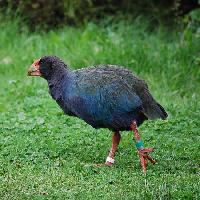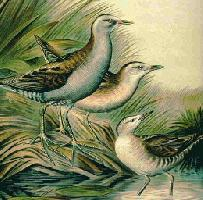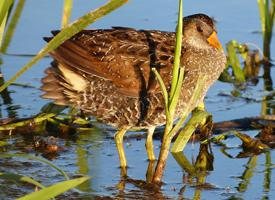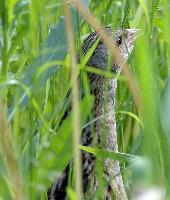
Váhy a míry
| Délka | 63 cm |
|---|
Stav ohrožení
| Ohrožen |
Popis zvířete
The North Island takahē (Porphyrio mantelli), also historically known as the moho, is an extinct species of flightless bird that once roamed the North Island of New Zealand. This fascinating creature was part of the rail family, which is characterized by their typically short wings, strong legs, and ability to thrive in dense vegetation. Despite its extinction, the North Island takahē remains a symbol of the unique and often vulnerable biodiversity found in New Zealand.Physically, the North Island takahē was a robust and striking bird. It bore a strong resemblance to its South Island counterpart, the South Island takahē (Porphyrio hochstetteri), which has managed to cling to existence. The North Island takahē boasted a vivid blue plumage on its chest and neck, contrasting sharply with the deep green hues on its back and wings. Its stout, red legs and feet were well-adapted for navigating through the dense underbrush of its forest habitat. The bird's bill was large, red, and robust, perfect for its primary diet of tussock grasses and shoots, which it would strip with efficiency.
Adult North Island takahē were sizable birds, reaching up to 50 centimeters in length and weighing as much as 3 kilograms. This size made them one of the largest rail species known. Their large size and flightlessness were adaptations to an island environment with few predators, a common evolutionary path for many bird species in New Zealand before the arrival of humans and other mammals.
The North Island takahē was a solitary and territorial bird, with pairs occupying and defending large territories where they foraged for food. Their social structure was largely monogamous, with pairs bonding for life and both parents participating in the raising of their chicks. This included teaching them how to find food and protecting them from the few natural predators they had.
Unfortunately, the arrival of humans in New Zealand brought about significant changes to the North Island takahē's environment. Habitat destruction due to deforestation and the introduction of mammalian predators such as dogs, cats, and rats led to a rapid decline in their population. By the late 19th century, the North Island takahē was considered extinct, with the last confirmed sightings occurring in the late 1800s.
The story of the North Island takahē is a poignant reminder of the fragility of island ecosystems and the devastating impact human activities can have on native species. Efforts to conserve the remaining takahē population in the South Island, as well as other endangered New Zealand birds, continue to be of critical importance. Through conservation efforts, New Zealand hopes to prevent further losses and ensure that its unique avian inhabitants thrive for generations to come.
Podobná zvířata
Nové fotografie zvířat
Top 10 zvířat
- Chinese water dragon (Physignathus cocincinus)
- Galápagos tortoise (Geochelone nigra complex)
- Dolphin gull (Leucophaeus scoresbii)
- Japanese macaque (Macaca fuscata)
- Colombian red howler (Alouatta seniculus)
- Sea urchins (Echinoidea)
- Diana monkey (Cercopithecus diana)
- Moustached guenon (Cercopithecus cephus)
- Common reed warbler (Acrocephalus scirpaceus)
- Common house mosquito (Culex pipiens)


